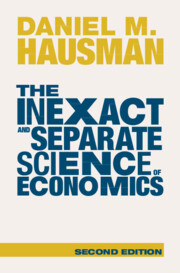Book contents
- The Inexact and Separate Science of Economics
- The Inexact and Separate Science of Economics
- Copyright page
- Contents
- Figures
- Tables
- Introduction
- Part I Introduction: Content, Structure, and Strategy of Mainstream Economics
- 1 Rationality, Preferences, and Utility Theory
- 2 Demand and Consumer Choice
- 3 The Theory of the Firm and General Equilibrium
- 4 Equilibrium Theory and Normative Economics
- 5 Equilibrium Theory and Macroeconomic Models
- 6 Models and Theories in Economics
- 7 The Structure and Strategy of Economics
- 8 Overlapping Generations
- Part II Theory Assessment
- Part III Conclusion
- Appendix An Introduction to Philosophy of Science
- References
- Index
2 - Demand and Consumer Choice
from Part I - Introduction: Content, Structure, and Strategy of Mainstream Economics
Published online by Cambridge University Press: 25 May 2023
- The Inexact and Separate Science of Economics
- The Inexact and Separate Science of Economics
- Copyright page
- Contents
- Figures
- Tables
- Introduction
- Part I Introduction: Content, Structure, and Strategy of Mainstream Economics
- 1 Rationality, Preferences, and Utility Theory
- 2 Demand and Consumer Choice
- 3 The Theory of the Firm and General Equilibrium
- 4 Equilibrium Theory and Normative Economics
- 5 Equilibrium Theory and Macroeconomic Models
- 6 Models and Theories in Economics
- 7 The Structure and Strategy of Economics
- 8 Overlapping Generations
- Part II Theory Assessment
- Part III Conclusion
- Appendix An Introduction to Philosophy of Science
- References
- Index
Summary
Although the normative model of rationality discussed in the first chapter is central to microeconomics, microeconomics is a positive theory describing, predicting, and explaining actual choices and their consequences. This chapter presents generalizations concerning market demand for commodities and services and consumer choice theory, which by means of economic models explains and to some extent corrects the generalizations concerning market demand. It presents an example of a simple economic model, where a consumer faces a choice between bundles consisting of only two infinitely divisible commodities, and it makes preliminary comments on the apparent empirical anomalies consumer choice theory faces. In reflecting on the theory of consumer choice and the explanation of demand, many questions arise concerning the structure of economic theory and whether the propositions of economic theory are in accord with the evidence. The material here should be familiar to economists.
Keywords
- Type
- Chapter
- Information
- The Inexact and Separate Science of Economics , pp. 56 - 72Publisher: Cambridge University PressPrint publication year: 2023

